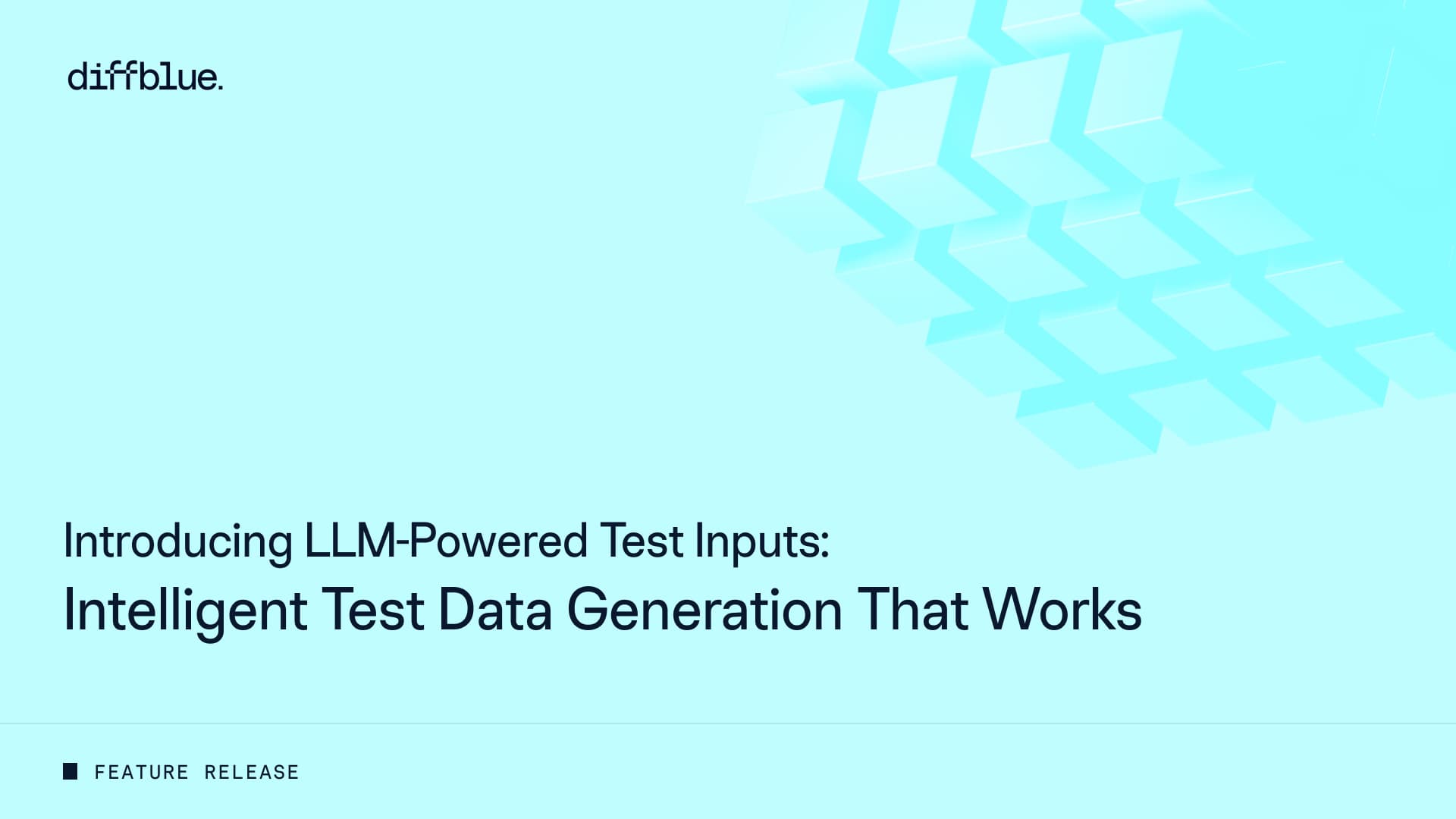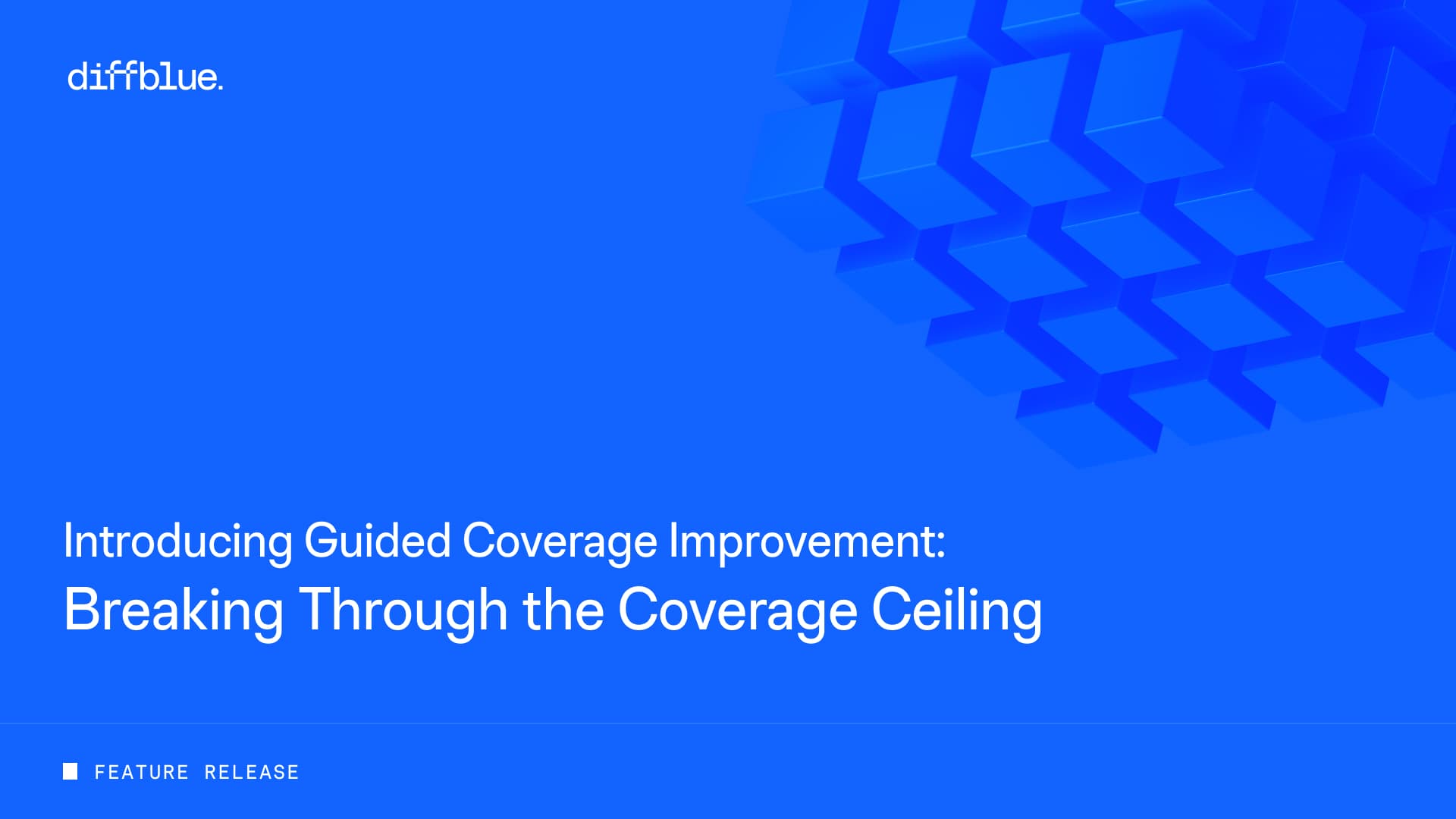We’re excited to announce a game-changing enhancement to Diffblue Cover: LLM-Powered Test Inputs. This innovative feature leverages large language models to generate realistic, context-aware test data, but unlike pure LLM solutions, our approach guarantees every test compiles, passes, and delivers value. Unlike token-hungry LLM assistants that can consume thousands of tokens per test, our approach surgically invokes LLMs only for specific, high-value test inputs using fewer tokens while generating tests faster.
The Test Data Problem No One Talks About
Every developer knows the scenario: You’re writing unit tests and need to create input data. What do you use?
- “test123” for that customer name field
- “string1” for the product description
- “[email protected]” for the email validation
- Random gibberish for that JSON payload
These generic inputs might make you pass coverage gates, but they fail to catch the subtle bugs that emerge when real-world data meets your code. Domain validation logic goes untested. Edge cases remain hidden. Branch coverage remains low because your test data never triggers those combinations of business logic conditions that depend on realistic values.
Why Pure LLM Approaches Don’t Solve This
The industry’s first instinct was to throw LLMs at the problem. After all, they understand context and can generate realistic data, right?
But pure LLM-based test generation has fundamental flaws:
- Unreliable Output: Tests that look good but don’t compile, throw exceptions or don’t assert what matters
- Token Explosion: Expensive, inefficient prompting and re-prompting to obtain a comprehensive test suite
- Unpredictable Results: No guarantee the generated tests will actually improve coverage
- Context Overload: Sending entire codebases to LLMs, hoping they figure out what’s needed
Our Approach: Precision Meets Contextual Intelligence
Diffblue Cover’s LLM-Powered Test Inputs takes a fundamentally different approach. We don’t use LLMs to generate entire tests, we use our proven reinforcement learning engine to identify exactly when and where contextual data would unlock new coverage, then surgically invoke LLMs only for those specific inputs.
Here’s How It Works
- Reinforcement Learning Explores Your Code: Our RL engine systematically analyzes your methods, identifying paths and branches with the same mathematical precision and guaranteed results it has always provided.
- Intelligent Detection: When the RL engine encounters a string parameter, a complex object, or a data structure that contains generic values blocking coverage, it recognizes that contextual data could unlock new test paths.
- Targeted LLM Invocation: Only then do we prompt your LLM—with precise, minimal context about what’s needed. Not the entire codebase. Not the full class. Just the specific information required to generate that one meaningful input.
- Seamless Integration: The LLM returns contextual data, our RL engine incorporates it, and test generation continues—fully automated, no manual intervention required.
Real Example: The Difference Is Clear
Before LLM-Powered Inputs:
@Test
void testExtractStandardReferences() {
ArrayList<StandardReference> result =
StandardsText.extractStandardReferences("test string 123", 0.25d);
// Test covers many lines, but misses crucial branches
}With LLM-Powered Test Inputs:
@Test
void testExtractStandardReferences_when025_thenReturnSizeIsFour() {
// Arrange and Act
ArrayList<StandardReference> actualResult =
StandardsText.extractStandardReferences(
"Applicable Documents: This system complies with ISO 9001:2015 Quality Management " +
"Standard and IEEE 802.11 specifications. Reference ANSI X3.4-1986 for encoding. " +
"See Publication NIST SP 800-53 and IETF RFC 2616 for security protocols.",
0.25d);
// Assert
...
// Rich, varied input that actually tests the parsing logic
}The difference? The second test actually exercises your parsing logic with realistic standards references, catching bugs that generic strings would miss.
Why This Changes Everything
1. Bring Your Own Model, Keep Your Control
We don’t force you into our LLM choice. Configure Diffblue Cover with your organization’s approved LLM—whether it’s OpenAI, Anthropic, or your private or local deployment. One-time setup, then it’s fully autonomous.
2. Cost-Efficient by Design
Unlike LLM agents that burn through tokens with lengthy conversations, we make minimal, targeted calls. Our RL engine does the heavy lifting; LLMs just provide the finishing touch where it matters.
3. Guaranteed Results, Every Time
This isn’t experimental. Every regression test we generate:
- Compiles without errors
- Passes at generation time
- Provides measurable code coverage improvement and high mutation coverage
- Executes at enterprise scale
4. Speed at Scale
The combination is blazing fast. RL explores efficiently, LLMs augment surgically, and you get comprehensive test suites without burning an entire rainforest in LLM compute—even on million-line codebases.
Available Now: The Future of Test Data Generation
LLM-Powered Test Inputs is available today in Diffblue Cover. This isn’t a beta or an experiment, it’s production-ready technology that transforms how your tests handle data.
The beauty of our approach? You don’t have to choose between the systematic exploration of reinforcement learning and the contextual understanding of LLMs. Our platform orchestrates both, using each technology where it excels, delivering results neither could achieve alone.
Getting Started Is Simple
- Configure Your LLM: One-time setup with your preferred provider
- Run Diffblue Cover: Same workflow, dramatically better results
- Review Your Tests: See realistic data, better coverage, more bugs caught
Just better tests, automatically.
Ready to see the difference intelligent test data makes? Start your free trial or contact our team to learn more about LLM-Powered Test Inputs.







